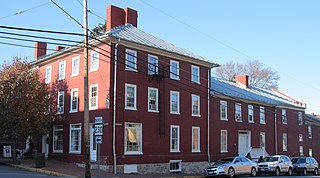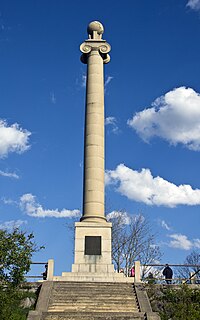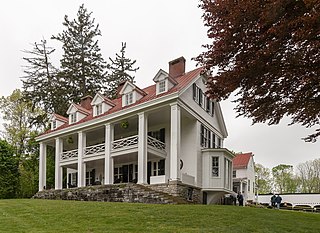
The Conrad Shindler House is a historic building, now home to the George Tyler Moore Center for the Study of the Civil War, in Shepherdstown, West Virginia.

The Conrad Shindler House is a historic building, now home to the George Tyler Moore Center for the Study of the Civil War, in Shepherdstown, West Virginia.
Located at 136 West German Street, in Shepherdstown, West Virginia, the Conrad Shindler House, circa 1795, is likely the second house to have been constructed on Lot 17, as the first recorded deed of sale between Thomas Shepherd and George Burket stipulated that to maintain ownership of the property, "[the owner] must build or erect or cause to be built or erected … one good dwelling house twenty feet long and sixteen feet wide with a stone or brick chimney…" So, as the first owner, George Burket (who retained ownership until 1773) likely built a small log structure with a stone or brick chimney at the corner of Princess and German streets. George and his wife Barbary Burket were therefore likely the first European occupants of a structure at Lot 17. Presumably this original structure was torn down and replaced by subsequent owners with the current structure dating to 1795. [1]
Michael Fouke purchased the property and its improvements in 1773 for £22 and held it through the American Revolution and into the early nineteenth century when he sold his claim to his sons and daughters. Fouke is known to have practiced carpentry in the Shepherdstown area in the late eighteenth and early nineteenth century which could indicate he was responsible for the construction of the circa 1795 structure. Beyond his role as a carpenter, little has been recorded of his life, yet one account puts Fouke at the launch of James Rumsey’s steam-powered boat on the Potomac River in 1787 where he exclaimed, "Why, sir, she could navigate through the Strait of Gibraltar."
Michael Fouke sold his ownership of the lot and its improvements to his children in 1810, but it is reasonable to assume he maintained residence in Shepherdstown with his children as they later preserved a life estate for him. With the vested interests in the home, George, Charles, John, Frederick, Michael, Christian, Phillip, and Elizabeth decided to sell their claims to the property to Conrad Shindler. One deed on November 29, 1813 retained the aforementioned life estate for George's father, Michael Fouke Sr. This insured a home would be provided for the remainder of the elder Fouke's life.
On April 17, 1815, Conrad Shindler gained full ownership of the property when he made a final purchase of claims on Lot 17 from John Fouke for $70. Incidentally, out of the original group of Michael Fouke's children who purchased the property in 1810, Charles and Phillip never sold their portion of the property, likely due to their death or some other calamity. Nonetheless, by April 1815, Conrad Shindler, a coppersmith and the son of a German immigrant, was the rightful owner of Lot 17 for the combined sum of $530.
Conrad Shindler's association with the building lasted officially from 1815 until May 8, 1852 when he died of natural causes.

Conrad Shindler was born in 1778, the son of Georg Conrad Shindler Sr. of York, Pennsylvania who was a Revolutionary War veteran of the York County Militia. His father made the trip from York County to Berkeley County, Virginia in the early part of the 19th century to settle in the region. Less than a decade later, Conrad Jr. purchased property in Shepherdstown on April 27, 1801, identified as Lot 3.
Shindler was a coppersmith, working at a yet undocumented forge in the rear of Lot 17. An original Shindler copper kettle is on display at the Historic Shepherdstown Museum in the Entler Hotel. [2]
From the 1815 Jefferson County Personal Property Tax lists it is evident that Shindler owned slaves from the outset of his stay at Lot 17. By 1835 these tax records show Shindler owning three slaves of unmentioned value or sex. By his death in 1852, a full assessment of his personal property was performed in accordance with his last will and testament. The assessment shows that Shindler owned seven slaves of varying ages and sex. Whether or not these slaves occupied the building at Lot 17 is not known; Shindler also owned two tracts of farming land outside town where they may have lived and worked.
After Shindler died, his property passed to his wife, Elizabeth Shindler, who is recorded in the 1869 Census as a 78-year-old woman living with her eldest son, John. When Mrs. Shindler died in 1869 her property passed to Conrad Shindler's heirs: John C. Shindler, George L. Shindler, Mary E. Bragonier, R.D. and Mary Shindler (of Nacogdoches, Texas), N.F. Hebb, and Eliza Hebb (of Sharpsburg, Maryland). These heirs sold their ownership of the property on October 28, 1869 to the "Trustees of the Reformed Church of Shepherdstown." This transaction and sale was never advertised in any local newspaper, and it is assumed that since Shindler's heir Mary E. Bragonier was married to the minister of this church this deal was in the works before Mrs. Shindler's death.
Under the auspices of the Reformed Church of Shepherdstown, later known as Christ Reformed Church, the property was used as a parsonage and, in subsequent years, for tenant dwelling. The property was owned by Christ Reformed Church until 1995 when it was placed on the market for sale by its trustees. Actress Mary Tyler Moore, a descendant of Conrad Shindler, purchased the property to create a permanent home for a Civil War Center to be operated by Shepherd College. [3]

Shepherdstown is a town in Jefferson County, West Virginia, United States, located in the lower Shenandoah Valley along the Potomac River. Home to Shepherd University, the town's population was 1,734 at the time of the 2010 census.

Poplar Forest is a plantation and plantation house in Forest, Bedford County, Virginia. Thomas Jefferson designed the plantation and used the property as a private retreat and a revenue-generating plantation. Jefferson inherited the property in 1773 and began designing and working on the plantation in 1806. While Jefferson is the most famous individual associated with the property, it had several owners before being purchased for restoration, preservation, and exhibition in 1984.

The Wilson-Wodrow-Mytinger House is a complex of three structures, built between the 1740s and 1780s, in Romney, West Virginia. The clerk's office, dating from the 1780s, is the oldest surviving public office building in West Virginia. The kitchen building is the oldest remaining component of the Wilson-Wodrow-Mytinger House and the oldest building in Romney. Throughout its history, the Wilson-Wodrow-Mytinger House has been known as the Andrew Wodrow House, the Mytinger Family Home, and the Mytinger House.

Shepherd Hall, also known as Monument Place and formerly as Stone Mansion, is a historic house listed on the National Register of Historic Places in the city of Wheeling in the U.S. state of West Virginia. It is located in the Elm Grove area of Wheeling, Ohio County, West Virginia.

Alexander Robinson Boteler was a nineteenth-century planter turned businessman, as well as artist, writer, lawyer, Confederate officer, philanthropist and politician from Shepherdstown in what was initially Virginia and became West Virginia in the American Civil War.

The Blount Mansion, also known as William Blount Mansion, located at 200 West Hill Avenue in downtown Knoxville, Tennessee, was the home of the only territorial governor of the Southwest Territory, William Blount (1749–1800). Blount, a Founding Father of the United States, a signer of the United States Constitution, and a U.S. Senator from Tennessee, lived on the property with his family and ten African-American slaves. The mansion served as the de facto capitol of the Southwest Territory. In 1796, much of the Tennessee Constitution was drafted in Governor Blount's office at the mansion. Tennessee state historian John Trotwood Moore once called Blount Mansion "the most important historical spot in Tennessee."

Faunsdale Plantation is a historic forced-labor plantation near the town of Faunsdale, Alabama, United States. This plantation is in the Black Belt, a section of the state developed for cotton plantations. Until the U.S. Civil War, planters held as many as 186 enslaved African Americans as laborers to raise cotton as a commodity crop.

Beverley, also known as Bullskin, is a farm near Charles Town, West Virginia that has been a working agricultural unit since 1750. The narrow lane that leads from U.S. Route 340 to the Beverley complex was, in the 18th and 19th centuries a toll road. The main house was built about 1800 by Beverley Whiting on the site of a c. 1760 stone house. The house is Georgian influenced Federal style, with a later Greek Revival portico. A number of outbuildings dating to the original 1760 house accompany the main house.

Morgan's Grove is a rural historic district near Shepherdstown, West Virginia. The area is noted for its abundant springs. Several historic houses and farms are in the district, including:

Rumsey Hall, also known as the Entler Hotel, is an historic building in Shepherdstown, West Virginia. The building is located in the center of the Shepherdstown Historic District and is a composite of six separate phases of construction. The earliest portion was built in 1786, and was the home belonging to Christian Cookus. This section burned in 1912. This section was separated by a narrow passage from the core of the hotel property, first started in the 1790s by owner Daniel Bedinger. This Federal style structure was expanded to the corner sometime before 1809, with a further addition along Princess Street by 1815. A kitchen and a carriage house completed the complex. Significant interior features remain. In 1809 a store was opened in the corner building, operated by James Brown. At about the same time, the Globe Tavern opened, offering overnight accommodations. In 1815, Bedinger sold the property to James Brown and Edward Lucas for $6,000. In 1820 it was again sold, to Thomas Crown of Washington, D.C., for $4000. By this time the tavern was managed by Thomas James and the hotel by Daniel Entler. In 1823, Daniel Entler became the manager of the entire property. The Entlers managed the properties until 1873, when they moved to Piedmont, West Virginia, while retaining ownership of the hotel.
Boidstones Place, also called Greenbrakes and Fountain Rock, was built in 1766 by Thomas Boydston near Shepherdstown, West Virginia on land he was granted by Thomas Fairfax, 6th Lord Fairfax of Cameron. In a dispute with Fairfax and Joist Hite over lands he had acquired along the Terrapin Neck on the Potomac River, Boydston lost most of his lands, which were acquired by Abraham Shepherd. The property formed a portion of the Shepherd's holdings along Shepherd Grade, which were primarily devoted breeding race horses. Some of the property was annexed to the adjoining Wild Goose property, owned by R.D. Shepherd, who had a racetrack there. In 1851 R.D. Shepherd gave Boidstones to his nephew and namesake R. D. Shepherd, Jr. who built the main Greek Revival section of the house. The property was sold out of the Shepherd family in 1886, but was returned to the Shepherds in 1916 for use as a summer place.

The Shepherdstown Historic District comprises the historic core of Shepherdstown, West Virginia. The town is the oldest in West Virginia, founded in 1762 as Mecklenburg. No structures are known to exist from the time before the town became known as Shepherdstown. The historic district is concentrated along German Street, the main street, with 386 contributing resources and 69 non-contributing elements. The chief representative period is the late 18th century, with many Federal style brick houses. German Street is also furnished with 19th-century "street furniture" such as metal fences, mounting blocks, wooden pumps and mature trees.
The George Tyler Moore Center for the Study of the Civil War, in Shepherdstown, West Virginia, is a Civil War research center at Shepherd University.

Rosaryville State Park is a public recreation area with historical features located three miles southeast of Joint Base Andrews in Rosaryville, Prince George's County, Maryland. The state park includes the restored Mount Airy Mansion, which is operated as an event facility, as well as hiking, biking and equestrian trails for day-use.
Hope Park was an 18th and 19th-century plantation in Fairfax County in the U.S. state of Virginia, where Dr. David Stuart (1753–1814), an old friend of and correspondent with George Washington lived with his wife, Eleanor Calvert Custis (1758–1811), and family. It was approximately 5 miles (8.0 km) southwest of Fairfax Court House.

Pitts-Inge is a historic commercial building located at Charlottesville, Virginia. It was built in 1820, and is a two-story, Federal style, brick building. Only the right half of the building, with two stories and the bays were part of the original structure.

The Claude Fouke House was a historic house at 501 Pecan Street in Texarkana, Arkansas. It was a two-story brick structure with a hip roof, set on a raised corner lot. It was one of the city's most elaborate Classical Revival structures, with a monumental temple front supported by pairs of fluted Ionic columns rising to the full height of the facade. The roof had an elaborate modillioned cornice, with a small triangular pediment containing a half-round window. The interior of the house contained equally impressive woodwork. The house was built in 1903 by Claude Fouke, the son of railroad baron George Fouke.

The James Rumsey Monument, also known as Rumsey Monument Park, is a municipal park and former West Virginia state park in Shepherdstown, Jefferson County in the U.S. state of West Virginia. The park overlooks the Potomac River. It commemorates local inventor James Rumsey and his successful public demonstration of his steamboat invention on the Potomac in 1787. The monument consists of a 75 ft (23 m) column of Woodstock granite, which is capped with a globe and stands atop a tall, concrete plinth consisting of a 40 sq ft (3.7 m2) plaza.

Wild Goose Farm is a 173-acre (70 ha) farm complex near Shepherdstown, West Virginia, established in the early 19th century. The farm includes a large, irregularly-arranged main house, a Pennsylvania-style bank barn, a tenant house, and outbuildings including a spring house, smoke house, ice house, corn crib, water tower and a decorative pavilion.
Sir Rose Price, 1st Baronet was a British baronet, plantation owner and Cornish landowner.
Coordinates: 39°25′50.4″N77°48′20.7″W / 39.430667°N 77.805750°W